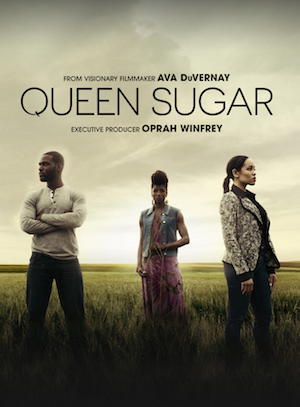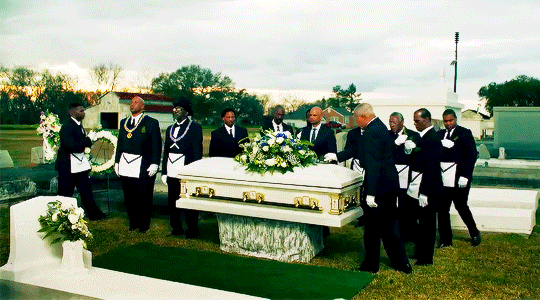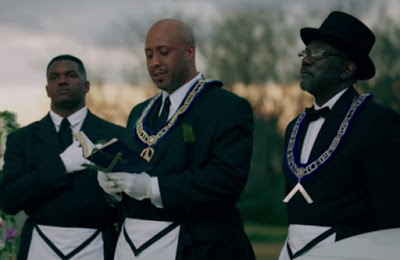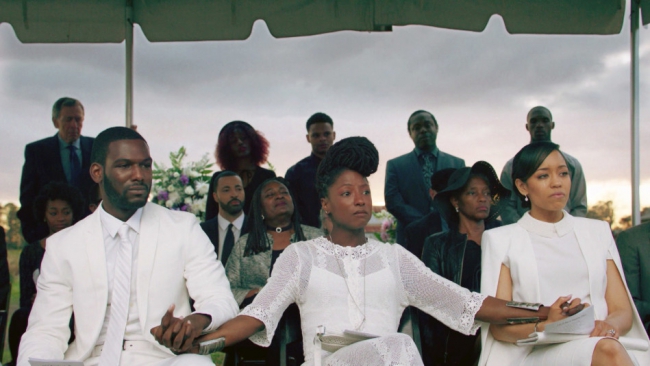 On September 6, 2016 Queen Sugar aired on the Oprah Winfrey Network (OWN). Based on the novel by Natalie Baszile, this television adaptation was co-created by acclaimed director Ava DuVernay and media mogul Oprah Winfrey. The series presents the complicated experiences of black lives in the twenty-first century and how these experiences have very real, even if invisible to most, historical underpinnings – namely American slavery – that bars present-day African Americans from land ownership, wealth building, gaining autonomy and physical independence. This legacy that American slavery has left is positioned alongside the issues of criminal activity, extra marital affair, and single fatherhood. Each play out at the intersection of race, gender, and sexuality but does not stereotype or pathologize the African American community. This has been attributed to its all-female band of directors who each direct a different episode resulting in how we see and understand Nova Bordelon, Charley Bordelon-West and Ralph-Angel Borderlon – the main characters of Queen Sugar. As the nucleus of the show, the series tells the story of the Bordelons, an African American family who owns an 800-acre sugarcane farm in the fictional city of St. Josephine located only a few hours drive from New Orleans, Louisiana.
On September 6, 2016 Queen Sugar aired on the Oprah Winfrey Network (OWN). Based on the novel by Natalie Baszile, this television adaptation was co-created by acclaimed director Ava DuVernay and media mogul Oprah Winfrey. The series presents the complicated experiences of black lives in the twenty-first century and how these experiences have very real, even if invisible to most, historical underpinnings – namely American slavery – that bars present-day African Americans from land ownership, wealth building, gaining autonomy and physical independence. This legacy that American slavery has left is positioned alongside the issues of criminal activity, extra marital affair, and single fatherhood. Each play out at the intersection of race, gender, and sexuality but does not stereotype or pathologize the African American community. This has been attributed to its all-female band of directors who each direct a different episode resulting in how we see and understand Nova Bordelon, Charley Bordelon-West and Ralph-Angel Borderlon – the main characters of Queen Sugar. As the nucleus of the show, the series tells the story of the Bordelons, an African American family who owns an 800-acre sugarcane farm in the fictional city of St. Josephine located only a few hours drive from New Orleans, Louisiana.
Throughout its first season, (now in its second) viewers were welcomed into the deep south to view black life lived – and lost. The second episode of the first season, aptly titled “Evergreen,” centered on the death of Ernest Bordelon, the father of the siblings on which the series centers. Within this episode Ernest was not just buried, illustrated by a typical cemetery scene preceded by eulogy. Instead, the cultural aspects of death and those intrinsic characteristics present within last rites rituals were shown and directly connected to African American culture and African American death ideology. Most notably, the fact that he was bestowed Prince Hall Association of Free & Accepted Masons obsequies. Fraternal orders were not just societies but burial societies. Members pooled their money and/or paid dues covering the funeral costs of lodge brothers and their families to avoid Potter’s Fields and open air burials. Using funds to cover the costs of burial plot and interment was especially important during a time when slave holders and later Jim Crow rendered such inhumation unnecessary. The connection made between masonry and African American burial practices illustrates the importance of a proper burial complete with ceremony and earthen burial.
With Ernest’s next of kin seated gravesite, his Prince Hall F. & A. M. lodge brothers stood surrounding the casket. In full regalia complete with aprons, they read sacred texts emphasizing the immortality of Ernest’s soul and the temporary resting place that is his gravesite, further illustrated by the sprigs of evergreen that filled their pocket squares eventually placed atop the casket. Common to African American death ideology is the circle of life, of which death is part. Life is not linear with death meeting one at the end. Death is the beginning of a new life cycle where the soul will live on in the hereafter that is near and not so far off. The belief stems from Traditional African Religion where upon last breaths the deceased become spirits, Human Spirits, who live between us and God, watching and guiding us and visiting us openly or in our dreams. Our deceased kin and ancestors are kept alive, like Ernest, by memorial and the remembering done by the living.
Memory-making in the African American community has always been a very important part of death practices. During the institution of slavery, the second funeral developed from a need of a proper memorial. Unable to convene and properly remember each family and friend at the time of their death, a gathering was held later (sometimes upwards to a year) at night in order to remember all who passed. Although important, as Karla Holloway explains memory-making in the black community can be difficult and troubling. Statistically and historically speaking, the death of African Americans is a result of violence, white violence, government-sanctioned violence, and systemic inequalities found within limited housing, food options, and job choices. So, although Ernest died in the hospital as if to drift to sleep, son Ralph-Angel still does not want Blue, his grandson, to participate in the memorial of grandfather’s death. Believed to be the continuation of life, death in the black community still directly involves the black experience which is underpinned with white supremacy – an obsession with owning and controlling black bodies. Ralph-Angel links Blue’s participation in the funeral as perhaps normalizing and even accepting his own future death from some aspect of structural racism.
Aunt Violet, Ernest’s sister, does not see it that way. Death is a way to say a final good-bye and perhaps more importantly, a visceral way to deal healthily with the abrupt physical separation of a loved one. In the end, Blue attended the funeral, shown graveside with the others. Matching Ernest’s casket, the family, except for Blue, was dressed in all white.
While at the funeral home with her other two siblings, Nova insisted on a white casket because Ernest, according to Nova, was “our black stone, our protection” and therefore only “light [should] send him back to the light.” In many African cultures white is the color of death. White symbolizes light and just like the torches carried during the funeral processions of old, the color was meant to send the deceased onward to the next life. In ancient Greek and early Christian death culture, the deceased were buried in white or wrapped in a white burial shroud. The funeral is a ceremonious send off with the casket as the chosen vessel of transport. The ancient Egyptians believed in immaculately preserving the body because it would be reconnected with the soul to live in the afterlife. Therefore, the casket can simultaneously be viewed as a very important storage or holding unit but also a vessel to withstand the journey.
The journey comprised a deathway consistent with the creole culture from which Nova was raised – a mixture of African, French, and Caribbean. She made this very clear by insisting on sewing a closed drawstring pouch into her father’s casket. Contents unknown, but the fact that she compared her father to a “black stone” (which signals strength and protection), I believe solves this mystery. Either way, this is a death ritual derived from the African Diaspora – where parts of African death norms survived and merged with the cultures they now reside. Further still, not placing the contents on the body but directly inside the lining of the casket assumes that the pouch, and its contents, concerned the safety and completion of the journey.
Last rites, death rituals, and funeral completed, the Bordelons, like many grieving African American families, sat down for repast – a post-burial meal where the bereaved surrounded by close family and friends were put on the path to normalcy. Death is jarring but with fellowship and sustenance the grieving are comforted. Big sister Nova quickly (and very loudly) reminded little sister Charley of this when Charley solicited the services of a catering company for the repast. “We don’t honor our father by sitting friends and family outside at fancy tables…[or] by having strangers serve those grieving,” snapped Nova, “We serve comfort food to those who need comfort – and we do it with our own hands!!” Nova was hearkening to the funeral tradition where family and those close to the family performed the funerary services, especially preparing and serving food. When death strikes in the African American community, particularly in the south where the Bordelon’s reside, usually it is food that is first sent and not flowers. Cakes of chocolate, coconut and jelly and entrees of chicken, potato salad and dressing fills the decedent’s home. The repast is for the living. The living must eat and continue to live although the appetite is the first thing to go when grieving. These are the foodways that Michael Twitty uncovered while “exploring culinary traditions of Africa, African America and the African Diaspora” that is particularly illuminated in his highly anticipated book, the The Cooking Gene. Twitty traced his southern roots all the back to Africa by following ingredients and food items. On this quest, he stopped at the plantations where his ancestors were the captives and the captors, visiting their graves, and cooking meals they frequently ate. Food, but more importantly, the planned fellowship filled with caring friends and warm memories of the deceased – that is the repast – is purposeful and important to African American funerary traditions.
Ultimately, the “Evergreen” episode of Queen Sugar illustrated the importance of a proper burial in the African American funerary tradition. A proper funeral meant respectable burial with the necessary last rites dictated by African American cultural death norms. Most times elaborate with the finest hearse, a proper funeral showcased the life the person lived. Ernest was a proud Prince Hall F. & A. M. lodge member indicated by the ritualized masonic ceremony performed. From the start, it was pertinent that Ernest have a casket worthy of the journey to the afterlife and one ceremonially blessed to protect him the duration. The all white his family was cloaked and him secured in his white coffin – with black stones that protected – was like a beacon heralding him to the afterlife. The African American burial tradition emphasizes the cycle of life which death is apart and with authentic and intricate story-telling, Queen Sugar captured the mourning as well as the memorial.
Dr. Kami Fletcher is an Assistant Professor of African American History at Delaware State University. Her research centers on African American burial grounds and late 19th/early 20th century Black male and female undertakers. She is the author of “Real Business: Maryland’s First Black Cemetery Journey’s into the Enterprise of Death, 1807-1920” and “African American Undertakers & Undertaking in Baltimore, MD, 1865-1910” forthcoming in the Maryland Historical Magazine. She is also the co-editor of the forthcoming volume Till Death Do Us Part: American Ethnic Cemeteries as Borders Uncrossed which examines the internal and/or external drives among ethnic, religious, and racial groups to separate their dead, under contract with University of Mississippi Press.
Dr. Fletcher is a guest blogger for Black Perspectives where she blogs about African American female/male undertakers, African American death ideology, and the history of Black Baltimore.
For more on Dr. Fletcher, please visit her website and follow her on Twitter.



